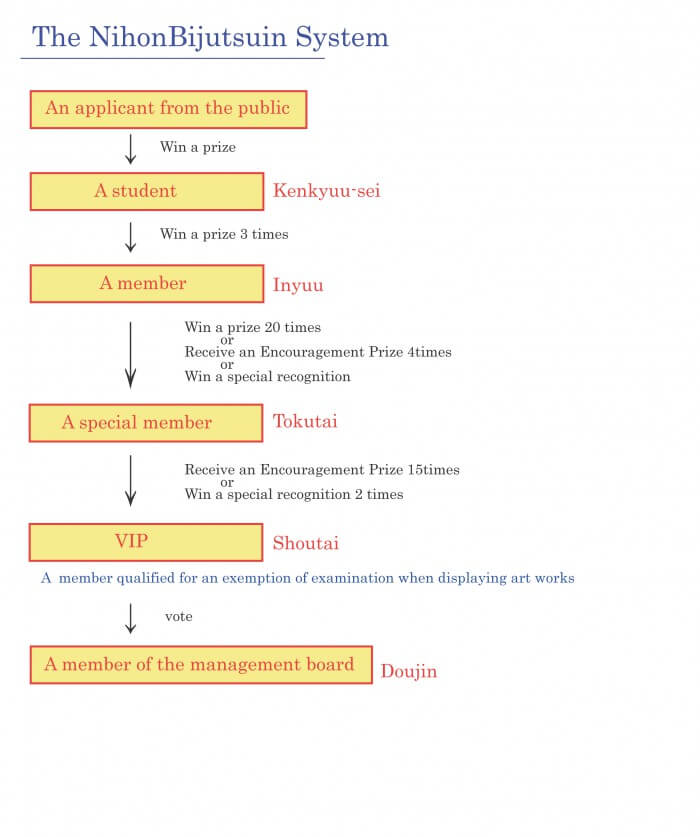Lesson
News / Blog
Other Menus
Famous Organization of Nihonga
Nitten (Japan Fine Arts Exhibition)
The “Nitten” is the most popular of all the great art organizations in Japan. The Nitten has a long and industrious history, which began in 1907 as a result of the First Ministry of Education Art Exhibition. In the beginning, the exhibition was referred to as the “Bunten.” In 1919, the Imperial Art Academy was established, and following this, the exhibition was renamed “The Imperial Art Exhibition” or the “Teiten.” In 1935 and 1937, the Imperial Art Academy was reorganized, and once again it was referred to as the Bunten. In 1946, after World War II, the management of the Imperial Art Academy was taken over by the Japan Fine Arts Exhibition, and the Nitten was formed. In 1958, the non-profit corporation Nitten was established, and the exhibition became privately managed. Recently, the Nitten has changed its legal status to a Public Interest Incorporated Association, pursuant to the reform of Public Interest Corporation System.
Throughout Nitten’s long and developing history, its contribution to the modern Japanese art world has been progound. Today, the Nitten claims to be the largest combined art exhibition of its kind in the world, attracting a great number of fans and critics. The Nitten comprises five art faculties; namely, Japanese Style and Western Style Paintings, Sculpture, Craft as Art, and Calligraphy. Each of the departments features works of new but talented artists alongside works of the great masters of modern Japanese art.
The Nitten is opened for public viewing every autumn at The National Art Center, Tokyo. It is expected that about 200,000 spectators will enjoy the exhibition prior to its tour of the principal cities of Japan; during the tour, another 300,000 people are expected to take part.

Nihon Bijutsuin (The Japan Art Institute)
“Nihon Bijutsuin,” called “Inten,” is a non-governmental artistic organization in Japan, dedicated to “Nihonga” (Japanese-style painting). The academy promotes the art of Nihonga through an exhibition, the “Inten” Exhibition.
History
The Nihon Bijutsuin was founded by Okakura Tenshin in 1898, together with a group of artists, which included Hashimoto Gahō, Yokoyama Taikan, Shimomura Kanzan, Hishida Shunsō, and several others, as a protest against the stylistic restrictions of the government-sponsored “Bunten” exhibitions. Nihon Bijutsuin moved, with Okakura to Izura, Ibaraki (now the city of Ibaraki) in 1906. However, Okakura soon lost interest in guiding the new organization to introduce Chinese and Japanese arts to the Western world via the Museum of Fine Arts in Boston. When Okakura died in 1913, the group dissolved. A year later, in 1914, Nihon Bijutsuin was revived under Yokoyama, who relocated it back to Yanaka, Tokyo. In 1920, separate sections were established for Japanese sculpture and for Western-style painting (“yōga”). The Western-style painting section was abolished in 1920 and the Japanese sculpture one was abolished in 1961. The institute is currently devoted exclusively to Nihonga painting.
Inten Exhibitions
The most important function of Nihon Bijutsuin is the organization and promotion of the Inten fine arts exhibitions. The Spring Exhibition is held in early April, for two weeks at the Mitsukoshi Department Store in Tokyo, followed by a tour around Japan for four months, at ten different locations. The sizes of the works which can be displayed is fixed at under 150 x 75 cm for rectangular works, and under 106 x 106 cm for square works.
The Fall Exhibition is held in September, for two weeks at the Tokyo Metropolitan Art Museum, followed by a year-long tour to 10 different locations around Japan. The Fall Exhibition contains larger works, with 225 x 180 cm as the upper limit.


